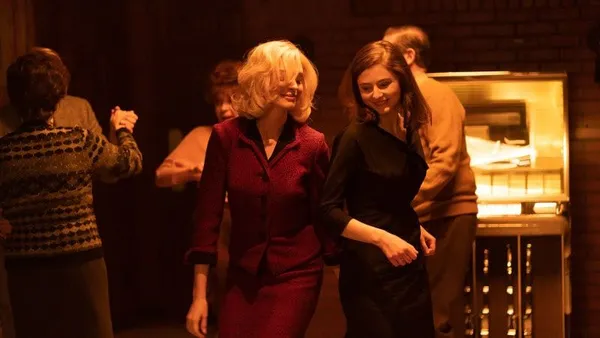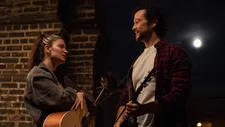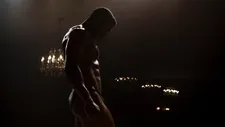 |
| William Oldroyd's Eileen Photo: Courtesy of Sundance Institute |
Going back to Park City for the first in-person Sundance Film Festival in three years felt a bit like reconnecting with an old friend. On one hand, it was familiar and comforting. On the other, there was a lingering sense that things may never be the same.
There were still big, hyped-up movies whose screenings turned into crowded clusterfucks — some things never change. Stars like Daisy Ridley, Anne Hathaway, Jason Momoa, the Indigo Girls and basketballer Stephen Curry drew rabid crowds to premieres of their latest projects, including Sometimes I Think About Dying and Eileen. But overall, proceedings took on a more subdued vibe, as screenings that would have quickly sold out three years ago proved much easier to access. Attendance at most press and industry screenings was particularly sparse.
Besides art cinema’s sluggish rebound from Covid, the likely explanation is streaming. While a few films were only shown in-person, most have been available online to independent film enthusiasts all around the world, meaning there’s less incentive to trudge through the snow and stand in lines in Park City. At the start of certain Tuesday screenings, the festival even showed a trailer in which attendees talked about how the best way to watch festival movies is online. The trend might not thrill lovers of theatrical cinema like myself, but it certainly made crowd control easier at a festival whose small host city has long been overextended.
It’s hard not to wonder whether the in-person festival will ever match its pre-pandemic glory. And, even more importantly, will art-house cinemas continue to have a piece of the exhibition market, or will theatrical movie-going become solely the realm of blockbusters?
A Strong Slate
Whatever the future holds, Sundance’s filmmakers and programmers have done their part to provide a quality batch of films for the upcoming year. While there weren’t as many films in the festival, standouts have emerged across genres, from fun romantic comedies to emotionally devastating tragedies.
The Premieres contained gems from established and up-and-coming directors. Eileen, William Oldroyd’s long-awaited followup to 2016’s Lady Macbeth, proves the director’s debut was no fluke. Set in the early 1960s, it stars Thomasin McKenzie as a young woman who lives a miserable small town life and works in a prison, where she befriends a seemingly glamorous new prison psychologist played by Anne Hathaway. With brilliant tonal shifts and lean storytelling, the film whisks you through a whiplash-inducing tale of longing, intrigue and societal pressure.
 |
| Crowdpleaser Flora And Son Photo: Courtesy of Sundance Institute |
Another director who hasn’t made a feature since 2016, John Carney of Once fame followed up Sing Street with the delightful musical Flora and Son. Eve Hewson stars as a single mother trying to learn guitar and encourage her thug son to play music. It’s the kind of story that could turn cloying or manipulative, but Carney has such a great sense of his characters and the truth of their lives that he somehow once again bottles lightning into a sweet, funny crowd-pleaser.
Other notable premieres include the endlessly inventive and unpredictable Landscape With Invisible Hand, in which a teenager lives in the aftermath of a nonviolent, economically driven alien takeover of earth, and the stylish romantic comedy Rye Lane, joyously set in South London.
The US Dramatic competition kicked off with Rachel Lambert’s Sometimes I Think About Dying, starring Daisy Ridley as an extremely introverted woman who struggles with human connection. Lambert wonderfully captures the dynamics of office small talk while letting Ridley subtly communicate her character’s bemusement and social anxiety.
Erica Tremblay’s Fancy Dance was a pleasant low-profile surprise that drew attention to the plague of missing or murdered indigenous woman in America. Beautifully acted by Lily Gladstone and Isabel Deroy-Olson, the film tells the story of an aunt and niece who get into trouble with the law while searching for their missing sister/mother.
Elijah Bynum’s Magazine Dreams will likely be talked about for Jonathan Majors’s disturbing performance as an obsessive body-builder with poor social skills and even worse anger management. The film doesn’t entirely work, but Majors is unforgettable.
In the World Cinema Dramatic competition, Noora Niasari’s Shayda tells the moving story of an Iranian mother living in Australia who hides from her abusive husband in a woman’s shelter. In the title role, Zar Amir-Ebrahimi surpasses her excellent performance in last year’s Holy Spider. She captures the feelings of living in fear of abuse while being unable to return to her home country due to its male-centered policies.
Saim Sadiq’s Pakistani film Joyland, a Cannes hit that made it to the Spotlight category, tells a different kind of story about strict religious rules tearing a family apart. It begins as an unsuccessful young man starts working for a trans woman nightclub dancer, and blossoms into a heartbreaking portrait of the man’s entire family, none of whom are getting what they want out of their traditional family relationships.
Also in Spotlight, Felix van Groeningen and Charlotte Vandermeersch’s The Eight Mountains left crowds bawling with its epic tale of a lifelong friendship in a beautiful Italian mountain village. See it on the big screen if you can — it’s gorgeous.
Caption Controversy
 |
| Magazine Dreams faced Closed Captioning problems Photo: Courtesy of Sundance Institute |
Variety reported that the entire US Dramatic Competition jury walked out of a screening of Magazine Dreams because jurist Marlee Matlin’s closed-caption viewing device was not working properly. In a Sundance that has had its share of technical issues (even the animated pre-film screens weren’t playing for the first couple days of the festival), this was the most egregious, as it directly affects audience members’ ability to watch the movies. If a non-celebrity deaf attendee had the same problem Matlin had, they probably would have just been told “oh well tough luck” and we might never have heard about it.
While I’m in favour of Sundance going to greater measures to make sure everyone can enjoy the films, I can’t claim to love the proposed alternative that’s been implemented at a few screenings: open captions for the hearing impaired. Perhaps it’s due to my passion for silent film, where too many intertitles is generally due to a shortcoming of craft, but I’ve found the festival’s open-caption viewings extremely distracting and unpleasant.
In fact, I’d challenge the title creators to think about what is really integral to the storytelling while writing them. Film is, after all, a visual medium. Sound design is important, but often the sounds are simply meant to help the story be more immersive. Throwing additional text on the screen has the opposite effect.
It doesn’t seem terribly helpful to editorialise with titles like “dramatic music continues,” but the true nuisance is the urge to describe incidental sounds. If a telephone rings and the character ignores it, or a gun shot is heard off camera, these are necessary audio cues the audience needs to be aware of to understand the storytelling. However, if we’re watching a character open a suitcase, it’s not necessary to know that the sound of the bag latch opening is heard, but we still had to read about it.
Of course, as I get into this tirade about open captions, I fear I know how some of my fellow Sundancers might respond: Why don’t you just stream the movie at home?





















